Vol 1 No. 38 TROPIC LIGHTNING NEWS November 11, 1966
Index
25th In Fiery Battle With Cong Div.;
Wolfhounds Repel 6 Wave Assaults
Rice Haul Triggers Action at Dau Tieng
Units of the 25th and 1st Infantry Division slugged it out with a Viet Cong
division in fiery action near Dau Tieng last week.
The battle was highlighted by six unsuccessful Communist human wave assaults
on the 25th's pinned down "Wolfhounds." The action took place on Operation
"Attleboro" in thick jungle 50 miles northeast of Saigon.
Toll
During the feverish five days of battle, which began last Friday, the enemy's
death toll was mounting at a rate of one every ten minutes, 24 hours a day, and
reached a figure of more than 750 by the week's end.
As the battle pitch became more intense, the "Tropic Lightning" infantrymen,
alongside soldiers from the 196th Light Infantry Brigade and the 1st Division,
pressed harder and harder in a relentless drive to rout the Communists from
their own backyard.
With the ripping sounds of automatic weapons and small arms fire and mortar
rounds cutting through the dense undergrowth came thundering barrages of
artillery and air strikes.
Assaults
The Viet Cong staged six human wave assaults, but each time the assaults were
repelled and the enemy casualty toll went higher and higher. During two of the
assaults, 100 VC charged toward the friendly units in a frenzied attempt to
break through. Each time they failed. On their third attempt, the number had
diminished to 35.
Several days before the battle began to rage, troopers from the 196th Brigade
had uncovered more than 1000 tons (more than 2 million pounds) of enemy rice in
a huge storage area south of War Zone C. The cache was the largest ever
discovered in the Vietnam war, enough to feed an entire VC division for 222
days. (See pictures, Page 4 and 5.)
Within hours after the enemy had tried to establish contact with the units of
the 196th who had found the rice, reinforcements from the 25th Division were on
the ground to assist. As they took their positions they were greeted by intense
fire from the enemy. And the fury of battle loomed.
Contact
The 1st Bn., 27th Inf., Wolfhounds quickly made contact with an estimated
company of VC and later with an estimated battalion of VC. Each time, the enemy
attack was repulsed.
Within 24 hours, the dense jungle area raged with heavy fighting, sometimes
with only a five meter interval between the friendly forces and the enemy. At
one time, the firing continued for six hours straight, without a lull.
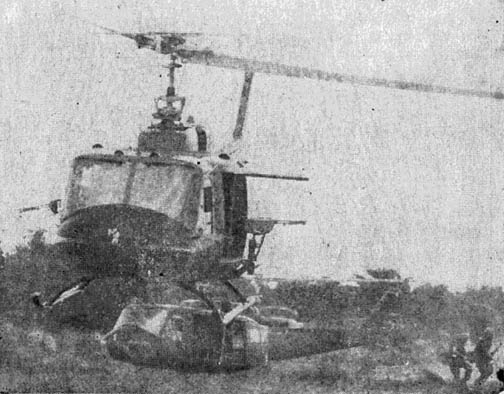 |
| THE BIG ACTION - Under heavy fire, a UH-1D helicopter from the 25th division lifts from a landing zone after dropping troops of the 196th Light Infantry Brigade. |
The 'Mad Minute' Lasts Six Hours
"What did it sound like when it first started?"
"Well, the only thing I can compare it to is the mad minute. The Infantry
School at Fort Benning has a problem where we try to tell young lieutenants
coming into the Army just what fire power an infantry company has."
"Every weapon in one whole company is fired at the same time for one whole
minute and the din of all those weapons at once is deafening. All I can say is
when it started, it was at least as loud as the mad minute, only it didn't let
up for about five or six hours."
Maj. Guy S. Meloy III, 35, of San Antonio, Tex., commander of the 1st Bn.,
27th Inf., was describing his unit's part in the fiery battles of November 4
and 5.
"The 'Wolfhounds' were embroiled in some of the bitterest close combat in the
Vietnam conflict against a force determined to protect its base camp area from
inside reinforced wooden and concrete bunkers.
The 1/27 was alerted on November 1, the same day they established a camp at
Dau Tieng. The next day it spent eagle flighting along the fringes of the
jungle canopy never before entered by allied forces. On the 3rd the men entered the jungle and established a
blocking force across it on the east-west trail.
"We would trap VC flushed by two battalions of the 196th Brigade, the 4th Bn.,
31st Inf., coming up east of the main north-south trail, and the 3rd Bn., 31st
Inf., coming up the west side. I dropped my Bravo Company in way up in the
northeast. I put my Charlie Company in up in the northwest, holding Alpha
Company in reserve. Pretty soon, Charlie Company was in one hell of a fight."
"Problems kept popping up," Maj. Meloy said. "As soon as I started to move,
my four company force ran into an estimated VC regiment. We had the infantry
school solution of point and flank security, and I'm sure if we hadn't, we would
have been wiped out. The VC opened fire at a range of less than 20 yards with a
higher proportion of automatic weapons than I've ever heard of a VC unit having
before."
"At the some time, C/2/2th in the middle of our little box was cut off and
pinned down in a savage fire fight. The other elements of our box each had
their own fire fight. I knew I had to rescue this stranded company so I started
maneuvering my companies. Every time I sent a company out, they took casualties
from the numerous machine gun bunkers, and I had to pull them back. I tried the
direct route, I tried going a three-quarter circle route the other way and I
tried again at night."
Finally, at noon of the 5th the stranded company linked up with the forces in
the northwest corner of the box.
"Again, we hadn't had any sleep that night," the major said. "I had spent
the whole night talking to a young Sp4 whose name I didn't know (Sp4 William H
Wallace, 23, Wissiston Park, N.Y., has since been awarded the Silver Star
Medal.) He had taken charge of the isolated company. He was scared out of his
wits, but he kept that company organized and followed my instructions."
Maj. Meloy grouped his companies together and started withdrawing slowly
around 4: 45 on the afternoon of the 5th.
"Then we called in the air strikes and artillery barrages and blew hell out
of the place," he said. "At the end there I was commanding 11 rifle companies
on the ground."
Maj. Meloy was awarded the Silver Star for his heroic actions in leading the
ground forces.
|
Latest Reports |
| Operation | Province | Began | FC | KIA | VCC | VCS |
| Attleboro | Tay Ninh | Sept. 14 | L | 764 | 8 | 56 |
| Lanikai | Long An | Sept. 15 | L | 22 | 4 | 36 |
| Paul Rev. IV | Pleiku | Oct. 18 | L | 197 | 33 | 23 |
Page 2 TROPIC LIGHTNING NEWS November 11, 1966
Decorated
| SILVER STAR MEDAL | |
| SSgt. Stephen Wedding, Co. C, 2nd Bn., 27th Inf. | |
| BRONZE STAR MEDAL (VALOR) |
|
|
Capt. James G. Andress, Co. C, 1st Bn. (Mech), 5th Inf. Capt. Leon B. Cloud, HH&S Btry., 1st Bn., 8th Arty. Capt. Archie L. Dowdell, HHC, 1st Bn. (Mech), 5th Inf. 2nd Lt. Matthew T. Durkovich, Co. B, 4th Bn., 23rd Inf. 2nd Lt. David P. Niles, Co. B. 4th Bn, 23rd Inf. 1st Lt. Anthony C.Trifiletti, A Trp., 3rd Sgdn., 4th Cav. 1st Sgt. Harold P. Powers, Co. B, 4th Bn., 23rd Inf. PSgt. James M. Deaton, Co. B, 2nd Bn., 27th Inf. PSgt. David C. Nelson, Co. B, 4th Bn., 23rd Inf. Sgt. Eduardo Conde-Colon, Co.A, 1st Bn., 27th Inf. Sgt. William L. McMillian, Co. B, 2nd Bn., 27th Inf. Sgt. Howard B. Lavy Jr., Co. A, 1st Bn., 27th Inf. Sp4 Jimmy W. Black, Co. A, 1st Bn., 23rd Inf. |
Sp4 Robert H. Cole, Co. B, 4th Bn., 23rd Inf. Sp4 James L. Corkern, Co. A, 2nd Bn., 27th Inf. Sp4 William P. Harnack, Co. A, 1st Bn., 27th Inf. Sp4 Walter J. Schroll, Co. A, 2nd Bn., 27th Inf. Sp4 Dalio S. Snodgrass, HHC, 1st Bn. (Mech), 5th Inf. Sp4 Leonard J. Ciolek, Co. B, 2nd Bn., 27th Inf. PFC Zdzislaw Feliner, Co. A, 1st Bn., 27th Inf. PFC Jessie D. Gonzalez, Co. A, 4th Bn., 23rd Inf. PFC Robert Harris, Co. B, 2nd Bn., 27th Inf. PFC Michael O'Shea, Co. B. 2nd Bn., 27th Inf. PFC Harold M. Patenaude, Co. A, 2nd Bn., 27th Inf. PFC Cordell G. Vanmeeteren, Co.A, 2nd Bn., 27th Inf. PFC Rafael P. Vicenty, Co. A, 2nd Bn., 27th Inf. |
| PURPLE HEART |
|
|
SSgt. Jerry B. Espy, A Btry., 13th Arty. Sgt. Marshall W. Goins, A Trp., 3rd Sgdn., 4th Cav. Sgt. Michael H. Martin, A Btry., 3rd Bn., 13th Arty. Sp4 David C. Bentley, Co. B, 2nd Bn., 14th Inf. Sp4 William L. Davis, Co. B, 2nd Bn., 14th Inf. Sp4 Michael Duganieri, A Btry., 3rd Bn., 13th Arty. |
Sp4 Jesse F. Simmons, A Trp., 3rd Sqdn., 4th Cav. Sp4 Charies H. Spinelli, Co. B, 2nd Bn., 14th Inf. PFC Richard J. Albert, A Trp., 3rd Sqdn., 4th Cav. PFC Thomas A. Dickson, Co. B, 2nd Bn., 14th Inf. PFC Thomas M. Fincher, Co. A, 2nd Bn., 27th Inf. PFC Lennis G. Jones Jr., Co. B, 2nd Bn., 14th Inf. |
Control of South Vietnam's Rice Could Determine Outcome of War
Rice to the people of Southeast Asia, to say nothing of the Viet Cong, is
survival - life itself.
Together with salt, and coupled with weapons, it is a basic consideration in
the conduct of this counterinsurgency war. Weapons determine the capability to
fight; food, the capability and the will to fight.
Since the first of the year, rice has been denied to the enemy in two
significant ways: First, through operations aimed at the protection of the rice
harvesting, and secondly, through search and destroy operations.
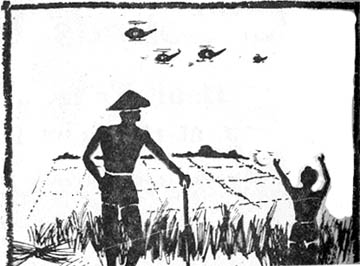 Operations Jefferson and Van Buren, conducted in January and February, were
directed primarily at the protection of the rice harvesting areas in Phu Yen
Province. The significance of this type of operation is evident from a
comparison of the last rice crop harvested in Phu Yen Province in 1965 which
yielded only 9000 tons of rice, with the recent ROK-ARVN Operation Jefferson
accounting for 30,000 tons.
Operations Jefferson and Van Buren, conducted in January and February, were
directed primarily at the protection of the rice harvesting areas in Phu Yen
Province. The significance of this type of operation is evident from a
comparison of the last rice crop harvested in Phu Yen Province in 1965 which
yielded only 9000 tons of rice, with the recent ROK-ARVN Operation Jefferson
accounting for 30,000 tons.
Tons
In regular search and destroy and "clearing" operations several thousand tons
of rice have been captured. Totals during this period were: Jan-1333 tons;
Feb-1113 tons; Mar-453 tons; Apr-2871 tons; May-1196 tons; June-1975 tons;
July-1181 tons.
Elements of the 25th Division recently captured more than 1000 tons of rice
in one single operation north of their base camp, leaving approximately 12,000
enemy troops without their daily rations for an estimated 180 days. (See story
on page 1).
But what is the real significance of these drives to deny the enemy his rice
harvest? What importance does rice assume in the Vietnam conflict?
Furthermore, what are some of the possible consequences of this loss of rice to
the individual enemy soldier and to his cause?
Life
Because the combat life of the guerrilla is replete with hardship and
privation, the additional burden imposed with the loss of food tends to weaken
his will to fight; lessens his effectiveness in battle, and finally, affects his
health by lowering his resistance to disease.
As the individual VC suffers so does his cause and his organization. The
logistic problems encountered by insurgents are difficult enough. Couple these
with the losses to search and destroy operations, bombings, artillery fire and
relentless coastal and inland waterway patrols aimed at cutting the infiltration
of weapons and supplies, and they assume discouraging proportions to the VC
logistic effort. Deprived of other alternatives, the VC supply system must
either purchase rice from farmers at a fair price, thus depleting their supply
of funds, or alienate the local population by confiscating the rice or taxing to
get more.
These logistical problems disrupt the enemy time table for operations.
Planning, always a VC strong point, becomes less exact, and more continent on
variables beyond their control. The element of calculated military risk rises
constantly until it becomes unacceptable. Finally, preplanned operations must he
indefinitely postponed or cancelled because the pre-located caches have been
destroyed.
The enemy does his fighting on rice. Deny him his rice ration and you hasten
his defeat.
Editorial
Far East Shopping
There's a certain boost to morale and a sense of well-being associated with
payday. The green stuff has a nice feel; the wallet is comfortably padded, and
the day somehow looks brighter.
Many of us have patronized local merchants in Far East cities. Servicemen
now Stateside may be doing the same thing in months to come. In every case the
motive of the servicemen is an honest one. He simply wants to buy merchandise
and send it home as souvenirs, gifts and mementos.
Uncle Sam has rules about such things, and they're strict ones, too. In some
cases the serviceman isn't even getting a fair shake for his money. He's just
throwing it away. So if you're in the Far East, or will be going there remember
the following three points:
1. Don't buy anything made in mainland China, North Korea or North Vietnam.
2. Don't buy Chinese-type goods in any country unless the shopkeeper can
supply a special certificate of origin acceptable to he U.S. Treasury.
3. Don't believe the shopkeeper who says you will be able to import Chinese
type goods without an acceptable certificate of origin.
Don't waste your money. Before you buy, check with your overseas command on
the latest regulations covering shopping restrictions. (AFNB)
| TOP TALK - Brig. Gen. Glenn D. Walker (c), former commanding general of the 3rd Bde. Task Force, explains the brigade's maneuvers on Operation "Paul Revere" to Army Vice Chief of Staff, Gen. Creighton W. Abrams (r). Lt. Col. Gilbert Procter (l), battalion commander of the 1st Bn., 14th Inf., looks on. (Photo by Sgt. Mike Horowitz) |
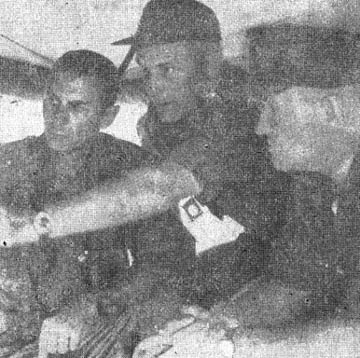 |
| The TROPIC LIGHTNING NEWS is an
authorized publication of the 25th Infantry Division. It is published
weekly for all division units in the Republic of Vietnam by the
Information Office, 25th Infantry Division, APO U.S. Forces 96225. Army
News Features, Army Photo Features, Armed Forces Press Service and Armed
Forces News Bureau material
are used. Views and opinions expressed are not necessarily those of the
Department of the Army. Printed in Saigon, Vietnam, by The Vietnam
Guardian. Maj. Gen. Fred C. Weyand . . . . Commanding General Maj. William C. Shepard . . . . . . Information Officer 1st Lt. William H. Seely III . . . . Officer-in-Charge Sp4 David L. Kleinberg . . . . . . . Editor Sp5 Jimmy Edwards . . . . . . . . . Editorial Assistant Sp4 Adrian E. Wecer . . . . . . . . Editorial Assistant |
Page 3 TROPIC LIGHTNING NEWS November 11, 1966
A's, B's, and C's
2/35th Teaches Cong
The 2nd Bn., 35th Inf., got little rest here recently as elements of the
battalion made contact with North Vietnam Army (NVA) Regulars on three
consecutive days.
Co. B engaged an estimated platoon of a NVA reconnaissance element while
patrolling outside the battalion perimeter on the first of the three days.
A heated fire fight killed four and wounded one NVA before air strikes and
artillery forced the enemy to withdraw.
On the second day, Co. C set up a one-night campsite during a search and
destroy mission and was hit by two companies of the North Vietnamese. The
enemy's infantry assault was scattered by three batteries of supporting American
artillery.
An Air Force AC-47 "Puff, the Magic Dragon" helped the "Tropic Lightning"
soldiers carry sporadic fighting into the night.
While "Charlie" Company was counting more than nine North Vietnamese bodies
the next morning, Co A moved in to assist and ran into a small enemy force.
"Alpha" Company plowed through the NVAs killing one and capturing another.
Days before, Co. A had killed four of an estimated NVA squad and captured
several miles of communication wire and a 7.62 mm Maxim machine gun.
Charlie Frustrated By 'Go Go' Boys
The night was hot and sultry. The ambush patrol from the 196th Light
Infantry Brigade's "Go-Go" Company - Co A, 4th Bn., 31st Inf., - had set up its
L-shaped trap two hours before and was now waiting silently for the Viet Cong.
Except for the gently swaying elephant grass, and an occasional frog or
lizard breaking the stillness, all was quiet.
Suddenly a new sound was heard. It was like the clicking of a cigarette
lighter. The patrol leader. Sgt. Robert Teal of Detroit, Mich., knew the enemy
was all around them.
The clicking increased. Then a grenade came in, flinging deadly fragments on
the patrol. Sgt Teal sprang the ambush and the patrol opened up.
Enemy small arms fire sprayed in from all directions. Realizing his patrol
had been outflanked, Sgt. Teal yelled, "Go, go!" It was the signal for the
patrol to break contact and return to its perimeter.
Swiftly his patrol moved out. Two men, Sp4 Brian Underwood of Buckannon, W.
Va., and PFC Mike E. Carey of Weston, W. Va., remained behind, throwing grenades
and spraying the enemy wherever they saw the flash of his rifle.
When they were sure the patrol had reached safety, they withdrew leaving
"Charlie" with just another frustration.
Ex-VC Finds Huge Tunnel
An ex-Viet Cong who headed a 100-man team of tunnel diggers in the area of
Tan Phu Trung, about four miles southeast of Cu Chi, led a division company to
one of his old projects recently.
The returnee let Co. C, 1st Bn. (Mech), 5th Inf., to a 1060 foot tunnel
consisting of five levels and six compartments.
Co. C made short work of the fortification, sending a group of tunnel rats
down to clear and destroy it.
Items captured from the tunnel included 4760 rounds of ammunition, a 30
caliber carbine, a Russian-made 7.92 mm rifle and a .45 cal machine gun.
| Waiting for The Big Play By Sp4 Richard Calvo The World Series was over, but in a sand-bag enclosed building, seven officers and two enlisted men of the 25th sat tensely listening to a radio. The radio blared and the group gave a quick cheer and settled back. The radio blared again, and the group took a deep breath and held on to its seats. Cigarettes being smoked by the scores and wrinkled brows indicated the strain within the small building. Leaving their seats, a few of the men paced thoughtfully across the room, anxiously turning toward the radio as static ruined its transmission. Closer As the evening wore on, chairs were moved closer to the radio and the crowd increased. It had been nearly 12 hours since the excitement began, and now the men were beginning to grow weary listening to the radio blurt out its information. Other men replaced them as the excitement mounted. By morning of the next day, everyone was back in his seat, more excited then ever. The big play they all had awaited was coming. Radio At another transmitting radio just five miles northeast of the "Tropic Lightning" Division's base camp, the 4th Bn., 23rd Inf., was ready to advance on an enemy force that had kept them bogged down for the preceding 18 hours. Cheers rolled out of the send-bagged tactical operations center (TOC) as reports of successful airstrikes and artillery barrages came from the field radio. Then wide grins crossed the weary faces as news that the "Tomahawks" were chasing the fleeing Viet Cong to the north came over the air. The men at the TOC had spent a long 18 hours. but now all the wait and strain seemed worth it. |
2/27th Fights From Treeline
Three Viet Cong were killed and two more captured recently during a search
and destroy mission south of Cu Chi.
Two companies from the 2nd Bn., 27th Inf., "Wolfhounds" were sweeping the
area when Co. A broke through a treeline and drew fire from the hidden enemy.
The company, pinned down in an open area, edged its way back into the
woodline while pouring heavy fire into the enemy position.
"We were hit by automatic weapons, carbines and rifle grenades," said
18-year-old Sp4 Aaron Thomas of Philadelphia. "I thought we might be in for
some trouble but once we got back into the trees I knew we could handle them."
PFC Steve Conway, 22, of Long Island, N.Y., added that the fire fight lasted
about 15 minutes.
A squad went in to search the area and found three bodies.
| 175th Builds Back Bone for Bridge The Vietnamese in the Tay Ninh area waded across the Soui Lam Vo River. The river had a bridge, but the people still had to wade across the river. Dilapidated almost beyond repair, the bridge, just three miles from the 196th Light Infantry Brigade base camp, sagged dangerously, preventing the crossing of heavy traffic. The 3rd platoon from the 175th Engineers offered assistance. Working with hand tools, a portable electric tool trailer and an air compressor, the engineers replaced the decking on the bridge with steel I-beam supports. When the job was completed, the class of the bridge was raised, allowing more traffic to pass. The bridge is located on a main access route that is used by military convoys as well as local farmers who cross it to buy and sell wares in Tay Ninh. Now, the people of Tay Ninh Province no longer have to wade the river. |
|
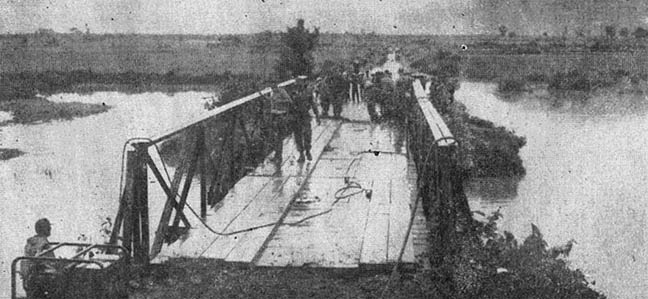 |
| POWER - A generator provides power for the men of the 175th Engineers to fix a local bridge. The engineers repaired the bridge so that the people of the area could cross the Soui Lam Vo River with greater ease. |
Page 4 - 5 TROPIC LIGHTNING NEWS November 11, 1966
[This issue of Tropic Lightning News was scanned from a bound
library volume provided by the 25th Infantry Division Museum. Some of
the photographs and captions on pages 4 and 5 were
printed across the center of the 2-page-wide sheet and partially hidden from sight - the book could not be
safely opened wide enough to see that
part of the page.]
196th -- THE CATCHERS OF THE RICE CACHE
|
Photos BySP4 James Pardue and PFC Vern Shibla |
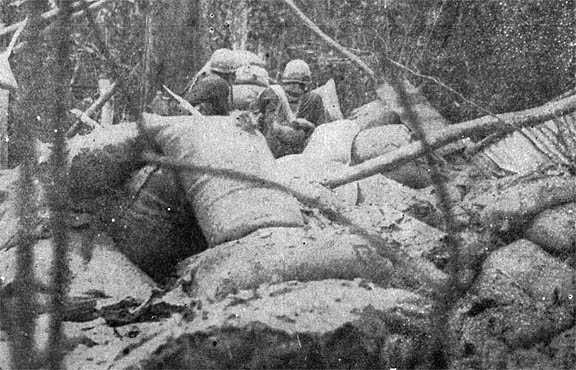 |
|
GUARD - 196th soldiers guard portion of the cache. |
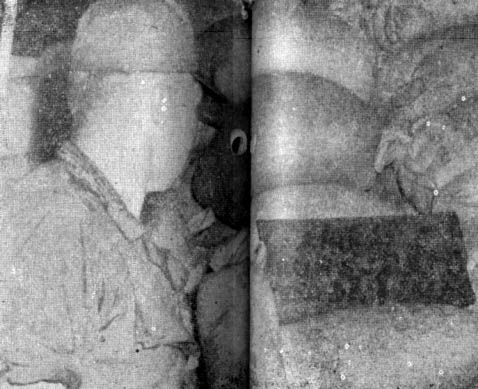 |
ATTENTION - 196th officer points to sign forbidding approach to this area ... Xin Loi, Charlie! |
| Rice... |
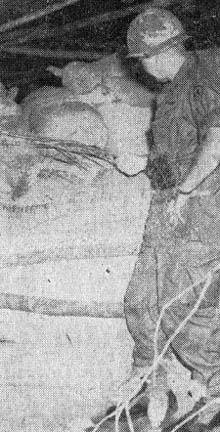 |
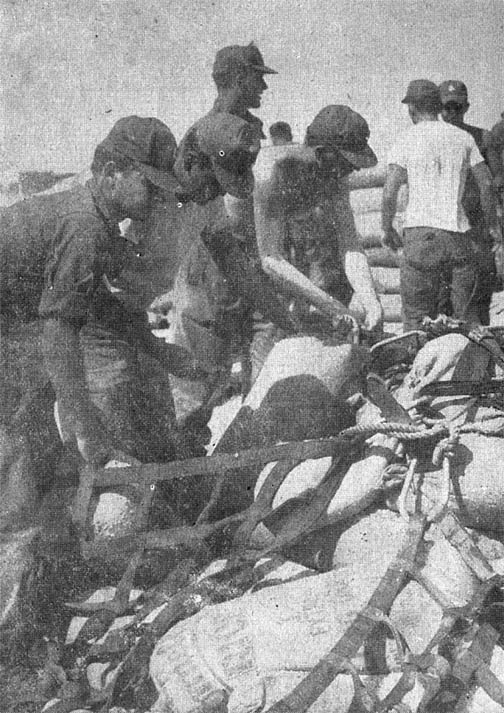 |
LOAD - Infantrymen of the 196th Light infantry Brigade prepare part of the 1000-ton rice cache for helicopter evacuation. |
| HAUL - 196th trucks and jeeps help in the process of removing rice cache from its jungle storage. |
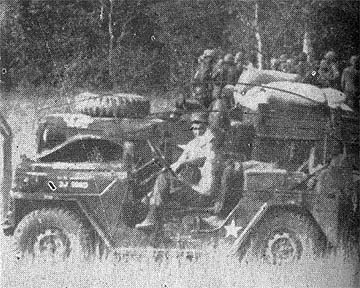 |
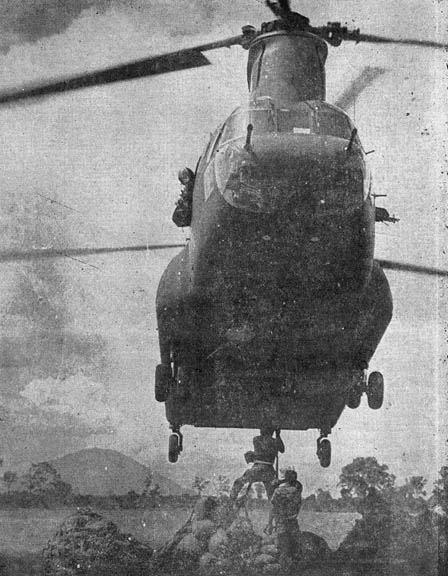 |
LIFT - Powerful Chinook CH-47 helicopters are used to air lift the cache. |
| ...Ready for air lift. |
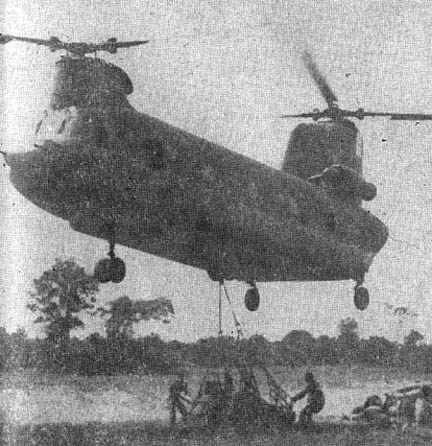 |
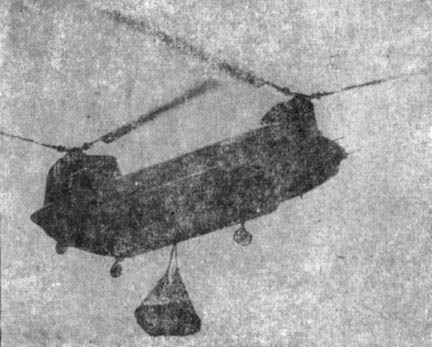 |
...Off to Tay Ninh |
Page 6 TROPIC LIGHTNING NEWS November 11, 1966
How Men of 4/23rd Felt Under Fire
What do men in fire fights think about? After interviewing five men of the
4th Bn., 23rd lnf., the answer seems to be nothing but fighting and winning the
battle.
When asked the question, the division troops gave such answers as: "There's
a time and place for everything;" "There is no time for free thoughts in a
fight;" "The main thing is to concentrate on what you're doing."
Sgt. William Farber, Sp5 Ralph F. Hunt, and Sp4's Garry P. Wenner, Henry
Jackson, and John A. Rudometkin had just returned from a 18-hour fire fight with
the V.C. They were still shaky from the action, yet they were willing to talk
about it.
"It was a nightmare," said Sgt. Farber, 20, of Ilion, N. Y. "I just hoped
I'd wake up in time."
"The VC were just 50 yards in front of us in a hedgerow and we couldn't see
them; their fire kept us down low. I was afraid that they'd come up through the
high grass and try to surprise us. The only thing we could do was lay very still and listen for their
movements."
Specialist Jackson, 22, of East St. Louis Ill., explained how he was in the
same predicament several yards away.
"I was lying in the paddy water watching flares being dropped. It was like a
summer night at home, but I couldn't enjoy it. There was something moving
through the water just to my front. I thought it better not to disclose my
position, so I signaled to a man on my right, and he threw a grenade into the
area."
"The grenade went off and the movement stopped. It was pretty quiet after
that but I kept alert and thought of nothing besides what I was doing."
"I didn't think of anything else either," asserted Specialist Hunt, 23, of
Portland, Ore. "Being a platoon medic, I really couldn't afford to. My job was
to take care of the men."
In agreement, Specialist Wenner, 22, of San Diego, Calif, added: "There
wasn't much time to think of anything except the fighting. Everything was
happening too fast."
Specialist Rudometkin, 23, of Milbrae, Calif., concluded that the only time
he thought of anything besides fighting, was when Companies B and C came
charging in as a relief column.
"My mind flashed back for a minute and I thought of my girl. I could afford
to, now, because with the coming of the reinforcements, I knew we were safe."
MEDCAPs Going Fine at Ben Luc
Capt. Morgan A. Cowan, presently serving as battalion surgeon with the 4th Bn.,
9th Inf., "Manchu" has the primary mission of treating U.S. and Vietnamese
forces on Operation "Lanikai," 18 miles southwest of Saigon in Long An Province.
But according to the captain most of his time is spent in his secondary
function: the Medical Civic Action Prograin (MEDCAP).
"Since we arrived here at Ben Luc on Sept. 15, we have treated more then 1300
local area people," he noted. "We are now conducting two to three MEDCAPs a
week. In addition, some of my staff always remains back at our base camp to
assist any American and Vietnamese and we have medical personnel on all of the
operations."
Commenting on the condition of the people around Ben Luc, Capt. Cowan
reflected, "They are no different from the people I've treated at clinics in the
United States. Generally the people here are well-fed and healthy. Most of all
they are genuinely interested in their own health."
"During the time we have conducted MEDCAPs in this area, I've treated people
for ear infections, colds, sores and things of this nature," the surgeon said.
"So far the most serious case we have encountered is one of advanced
tuberculosis."
The captain provided more details about his operations by saying that on
MEDCAPs his men make available vitamins, iron tablets and aspirins, soap, all
of which the villagers eagerly accept.
The soap his men supply to the villagers has been donated by the people of
Hawaii under the "Helping Hand" Program.
Batter Up: 'The Man' Is Coming
Stan Musial, the former all-time great for the St. Louis Cardinals, heads a
list of baseball dignitaries scheduled to visit Cu Chi next Monday as part of
their tour of Vietnam.
Musial, a member of the President's physical fitness program, will accompany
Brooks Robinson, power-hitting third baseman of the world champion Baltimore
Orioles, Harmon Killebrew, Minnesota Twin home run slugger, and the Atlanta
Braves' outfielder Hank Aaron and catcher Joe Torre.
Mel Allen, baseball broadcaster, will accompany the players.
The Clara Ward Singers are slated for an appearance at Cu Chi November 24.
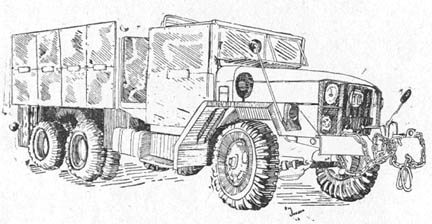 |
Only 725th Knows For Sure
Armored Cow Is Something
Right now you are probably asking yourself, "What is an armored cow?"
To begin with, the term "Armored Cow" comes from two words: armored and cow.
Armored means "covered with armor" and cow means a "mature female of the bovine
species."
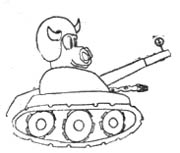 Therefore, an armored cow is a bovine in a cast iron corset, right? Wrong -
An armored cow is a 2 1/2-ton truck covered with 1/2" titanium.
Therefore, an armored cow is a bovine in a cast iron corset, right? Wrong -
An armored cow is a 2 1/2-ton truck covered with 1/2" titanium.
Titanium is a dark-gray, lustrous, metallic chemical element found in various
minerals and used as a dioxidising agent in molten steel. Only in this case, it
is used for armor plating on a 2 1/2-ton truck.
The armored cow was created for the 25th Division by Co. C, 725th Maint. Bn.
The 1500 pounds of armor make the truck virtually impervious to small arms fire
even at close range.
These vehicles are used by Co. B of the 25th S and T Bn. to convoy troops to
and from Saigon. They are manned by a driver and a shotgunner. The shotgunner
is armed with an M-79 grenade launcher which might lead one to think he would be
called a grenade launcher but he is not: He is called a shotgunner.
This leads one to wonder what the title would be for the soldier who carries
a shotgun. He is known as a rifleman, not to be confused with the rifleman who
carries a rifle. But that's another story.
Former VC Sings New Life
Members of a Viet Cong unit in the Cu Chi area are being treated by an
ex-comrade to a musical rendition of a guerrilla's woes and a Hoi Chanh's
(returnee's) advantages.
The ex-comrade, a grenadier who turned himself over to the government under
the Chieu Hoi (open arms) Program, surrendered at an Army Republic of Vietnam (ARVN)
compound in Ap Cay Trom, about four miles from the division's base camp.
During questioning, the returnee explained that he formerly sang classical
Vietnamese music in Saigon. Believing Viet Cong propaganda, he joined the VC
last year and became a front line soldier in Tay Ninh Province.
Before long, the 20-year-old became dissatisfied with VC life and
objectives. One morning in late October, the grenadier was ordered to go to Loc
Hung, a village about 10 miles northwest of Cu Chi to buy food. He slipped from
the village and walked six miles to the ARVN compound to turn himself in.
At 25th Division headquarters, the returnee offered his services as an
entertainer and wrote music and words for a song explaining the advantages of
becoming a Hoi Chanh.
Division psychological operations personnel taped the performer as he
accompanied himself on a guitar and the ballad is now played through
loudspeakers mounted on helicopters dropping leaflets on the unit.
The balladeer seemed confident that his song would become a hit in his old
unit. "They'll recognize my voice," he said. "I sang to them often."
'Diamond Heads' Tap Power For Better Cu Chi Living
Three men of Co. B "Diamond Heads", 25th Avn. Bn., recently remembered the
slogan "live better electrically" and set out to increase the unit's electrical
supply.
To undertake such a task, a utility company has to be formed. Diamond Head
Utilities (Unincorporated) was born, with the company's founders being CWO
Curtis R. Hayter, president; WO Gary Eddy, vice president in charge of wiring,
and Spy James Sampsel, generator repair foreman.
To begin, a generator of French manufacture, 1940 vintage, was received from
a salvage yard. Although the generator was in good condition, its engine was
beyond repair. In searching for an engine with which to drive the generator, a
1944 model marine diesel engine was acquired.
Now the problem of connecting the engine to the generator confronted the men
of Diamond Head Utilities. This, however, was easily solved, as the drive shaft
of a 3/4-ton truck was pressed into service.
As an ample supply of electricity flowed into the unit, Diamond Head
Utilities became aware that their marine engine driving the generator also had
potential as a hot water heater.
Page 7 TROPIC LIGHTNING NEWS November 11, 1966
1/5th Officer Accepts His First Hoi Chanh
A 25th Infantry Division officer has become the first American in Hau Nghia
Province to welcome a Viet Cong back to the government. To make the feat even
more unusual, Capt. Arzhie L. Dowdell, civil affairs officer for the 1st Bn. (Mech).,
5th Inf., took in two of the returnees in as many days.
While working in the village of Tan Phu Trung, 15 miles northwest of Saigon,
the 30-year-old captain was observing the processing of Hoi Chanhs (returnees).
He felt the U.S. Army could use the ex-Viet Cong for intelligence purposes.
When a fourth Viet Cong turned himself in at the village, Capt. Dowdell spoke to
the village chief.
A few days later, the chief told the captain to visit a nearby house. He was
introduced to a man who immediately surrendered. The man was a Viet Cong who
wished to turn himself over to the Americans and become the first "American Hoi
Chanh."
Using an interpreter, Capt. Dowdell interrogated the ex-Viet Cong. Through
kindness and understanding, the civil affairs officer won his confidence. To
show his gratitude, the Hoi Chanh traveled the following day into the
well-known jungle surrounding Tan Phu Trung. There he met his friend and spoke
of the kindness he had received. This convinced the Viet Cong that he should
follow in his friend's footsteps, and so he did.
Upon returning to the village, the men are now working with elements of the
division's 2nd Brigade, supplying much needed intelligence data for the U.S.
fighting men in Hau Nghia Province.
U.S. Casualties Near 6000 As of Oct.
DOD statistics reveal that 5566 U.S. service personnel have lost their lives
from actions by hostile forces in Vietnam from Jan. 1, 1961 through Oct. 15,
1966. Additionally, 1187 died from non-hostile action causes. (CD)
Saigon Orphans Helped
Douglas Knott may no longer be alive, but a memorial to him will live forever
in the hearts of the orphans and underprivileged youth at the Children's Home of
Blessing in the Cholon section of Saigon.
The young soldier was killed on an operation with the 1st Bu., 27th Inf.,
"Wolfhounds." Mr. and Mrs. Howard E. Knott, of Kettering, Ohio, asked all their
friends at the Concordia Evangelical Lutheran Church in Dayton to contribute to
a memorial in lieu of sending flowers.
The Knotts reasoned that Doug, who had expressed concern for homeless and
poverty-stricken children in his letters, would best be remembered by aiding
these children he liked so much.
Mrs. Knott wrote Doug's chaplain, Capt. John. A. DeSaegher, and
asked him to recommend a protestant orphanage in Vietnam that needed the money.
Chaplain DeSaegher contacted the Rev. Gordon Cathy of the Christian and
Missionary Alliance at the International Protestant Church in Saigon. Rev.
Cathy at once recommended the Children's Home of Blessing.
Chaplain DeSaegher's choice was acceptable to Mrs. Knott and she forwarded
the $500 memorial fund to the Reverend Cathy. He in turn was overwhelmed by the
generosity of the Knott family and has decided the fund will be used to put up
more buildings at the home dedicated to the memory of Douglas Knott.
Chaplain DeSaegher said he got to know Doug during the six months they served
together because he attended services regularly. He said, "He was a real fine
fellow, and I think his parents are doing a wonderful thing in his memory."
| RAIN OR SHINE - Two members of the 1st Bn., 14th Inf., "Golden Dragons" watch as a CH-47 "Chinook" helicopter brings a 105mm howitzer from Btry. B, 2nd Bn., 9th Arty., into a landing zone during heavy rain. (Photo by Sgt. Mike Horowitz) | 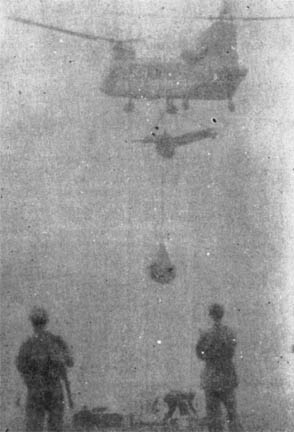 |
TROPIC FLASHES
65th Engr. Bn.
Construction work on the "Lightning Memorial Chapel" is under way by members
of Co. C. Expected to be completed in time for Christmas-Chanukah services, it
will accommodate 175 men.
According to its designer, 1st Lt. Ronald E. Heck, it will be similar to the
battalion's chapel which is now in use.
Meanwhile, an open-air building of brick rustic wood, with a corrugated
aluminum roof is taking shape at the northern end of Lightning Loop.
2nd Brigade
Former brigade commanders were honored at a recent ceremony at the "Warrior
Club" officer's club. Lt. Col. Thomas U. Greer and Lt. Col. Harley F. Mooney
were presented scrolls, commemorating their tours as battalion commanders.
Col. Greer is presently the division G-5 and Col. Mooney is serving as the
"Tropic Lightning" G-2. Col. Thomas M. Tarpley, brigade commander, made the
presentations.
Chaplain (Maj.) Hal Carruth held Protestant services last week, marking the
first service in the brigade's new chapel. Official dedication of the chapel is
planned for Nov. 20.
Cigar smokers include Richard L. Williams and Anthony S. Gonzales as they
were promoted to sergeant and Sp5 respectively.
1/5th
A hearty welcome to two lieutenants, arriving recently at the battalion. Lt.
Fred L. Hulett is now serving with Co. B while Lt. James Gilbert has joined Co.
A.
1/14th
1st Lt. Perry E. Royston recently received four letters, each one bearing the
exciting news that he is a father. He heard first from his wife, then his
mother, his aunt and finally from a Navy Speed Letter. Anyway, he got the
message and the unit extends their congratulations.
196th Brigade - 2/1st
A race is now under way between Companies A and B to see which becomes the
first mobile company of the 196th Light Infantry Brigade. The heated contest
was prompted by events which took place during the unit's recent search and
destroy mission in the Boi Loi Woods. In their search, they found the VC were
quick to abandon their bicycles and flee on foot through the jungle at first
sight of the advancing Americans. Result: captured enemy bicycles that can be
kept by the capturing unit as war trophies. At last report Co. B. is well in
the lead with 18 bicycles compared to theee for Co. A.
3rd Brigade
Gen. W. C. Westmoreland, COMUSMACV commander, paid a recent visit to the
brigade's forward command post. There he was briefed by Col. James G. Shanahan,
brigade commander, concerning operation Paul Revere IV.
2/27 Stops V.C. Mail
If the Viet Cong's morale. takes a slight turn for the worst, it's because
their mailwoman turned her parcels over to the 2nd Bn., 27th Inf., "Wolfhounds"
recently.
The young woman was captured while the Wolfhounds were on a search and
destroy mission a few miles south of the Cu Chi base camp. While searching a
village, Sp4 Fred Robinson, 20, of St. Paul, Va., walked into a house and saw a
woman.
"I took her from the house and began leading her toward the interpreters when
all of a sudden she stopped near a hole and pulled out a small plastic bag
containing some papers," explained Specialist Robinson.
They were letters from VC to their families.
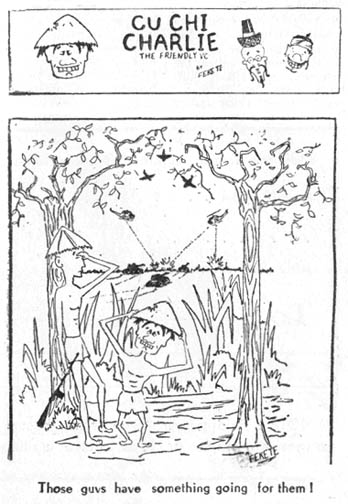 |
Page 8 TROPIC LIGHTNING NEWS November 11, 1966
1/8th Roars for Wolfhounds
By PFC Andy Jensen
When the two battalions of the 27th Infantry called for support from the 1st
Bn., 8th Arty., during the rugged two-day battle on Operation "Attleboro" they
got it at the rate of more than four rounds a minute.
On November 4 and 5, companies from the 1st and 2nd Battalions of the 27th
Infantry encountered an estimated battalion size Viet Cong force.
Artillery support was fired by the "Automatic Eighth" from a forward position
north of Cu Chi.
On the first day of the battle, a Wolfhound company from the 1st Bn., against
an estimated VC battalion, called for artillery.
Infantrymen on the ground were less than 75 yards from the enemy who were
fighting from well fortified hunkers. The artillerymen laid their barrages on
target.
On the morning of November 5, elements of the 2nd Bn. were heli-lifted in to
reinforce the beleaguered company. As the battle raged on the second day and
units moved forward, artillery fire kept the Viet Cong pinned down and cut off
any support from the rear.
During the extraction artillerymen provided cover fire. At the end of the
two day ordeal one battery of the 8th had fired for 12 straight hours.
Infantrymen engaged in the heated clashes agreed they would rather have been
where they were rather than on the receiving end of the constant barrage of
artillery.
The enemy was not available for comment.
| Sgt. Tells of VC 'Waves' By PFC Doug Kearney "I heard them let out a whole bunch of whooping and hollering and screaming and then there was about 100 of them coming at us through the undergrowth." "They popped up out of their holes on line at a dead run for our positions. There were so many of them so close together, they could have held hands with the men on either side of them as they charged us." Wounded That was how a wounded sergeant from the 1st Bn., 27th Inf., "Wolftounds" described the height of the action on November 4, in the dense woods south of War Zone C during Operation "Attleboro." The sergeant had gone into combat late the previous afternoon in relief of Co. C. His whole company, Co. A, and Co. C. were awake all night ready for an attack that never came, and in the morning they were moving forward. "It was about 11:15 and we had been moving slowly through the woods all morning. All of a sudden machine gun and automatic rifle fire seemed to come from everywhere. At the nearest, the VC were about 15 yards away." "The fire was real bad, especially on the left flank. We had been moving through the woods with one platoon line and the others were in a trailing file. We had to bring the other platoons on line but the fire was so intense that the best we could do was to form a crescent-shaped line. This formation kept the VC from outflanking us." Trees "The VC were in trees and dug-in hunkers and spider holes. Their fortifications were arranged so that each one could cover the hunker on either flank. They had machine guns and automatic rifles everywhere." "Around 3:30 the first wave came. It was like I said. They seemed to be everywhere. They had to run about 25 yards to get to us, but we stopped them about 12 yds away. They were dressed in new, regular uniforms with plenty of field gear. The bodies we looked at were very well equipped with extra clothing, rations, cooking utensils and medical supplies." "After we repelled that charge, the fire fight was the same as before, maybe a little heavier. Around 6:45 we heard that our sister battalion, the 2nd of the 27th, was on the way closing in behind the VC. When the men got the word, we all let out a big cry of "Wolfhounds." Then the second charge came at us." 60 to 65 "This time there were about 60 or 65 of them. We didn't fire our rifles because we were afraid of hitting the men of the other battalion. We had to use hand grenades to stop the charge. They got within two or three yards of us before the charge broke up. All the time they were charging, they had their guns blazing, but they weren't firing very effectively." "The jungle was so thick out there and the firing was so heavy, that the bullets were cutting and toppling two-foot thick rubber trees. It was so thick you couldn't see a man hiding five yards away." "Toward nightfall the VC finally fell back and we got a look at their bunkers. They were really dug-in and fortified with one-foot thick logs. They were arranged so the fire came out about one foot off the ground." Party "That night we could hear the wounded VC screaming and moaning, but the rest of them sounded like they were having a party or something. They were singing and dancing and carrying on and one Charlie was out there by himself screaming and singing and throwing hand grenades every which way." "Our medics were really great out there. Whenever you got a foot off the ground you'd get hit. But whenever anyone called for a medic, one of these guys would break cover, get up and run to help through all that heavy firing." "And our men were great too. When that fanatical assault came at us, nobody panicked. All of them were up there, firing at the Cong for all they were worth. You couldn't have asked for a better bunch of guys." |
1/14th Kills 24 Cong
Co. A, 1st Bn., 14th Inf., recently killed 24 North Vietnamese Army (NVA)
soldiers and captured two others in less than 24 hours of fighting.
The initial enemy contact was made just after noon when a fire team from the
3rd platoon spotted a small group of enemy soldiers.
Soon the entire platoon was engaged in a fire fight with an estimated NVA
platoon. Small arms, automatic weapons, machine gun fire and grenades were
being hurled at the "Golden Dragons."
Friendly units withdrew to the landing zone to evacuate the wounded. Air
strikes and artillery were quickly called in.
Sp4 Hit But Keeps Fighting
"The VC were creeping up on us from all over and the fire was so heavy trees
fell like bowling pins." The 23 year old rifleman from Temple City, Calif., is
a member of the 1st Bn., 27th Inf.
The "Wolfhounds" arrived in Dau Tieng on November 1. Early the next morning,
Specialist Harnack and his comrades from Co. A hacked their way through thick
underbrush on a defensive security sweep.
"I was on the left flank with the second platoon and about 30 meters ahead of
them. About halfway through a village I saw a VC pop up and before I could do
anything, he got me in the shoulder," Specialist Harnack said.
Specialist Harnack, hit before noon, didn't stop fighting until late
afternoon.
"Right after I was hit I saw three VC charging me. I lifted my rifle and
killed one of them. I thought I was a goner but a machine gun let go behind me
and chewed the other two apart. The company was on line with me now and raising
cane. The pain in my shoulder was terrible and a bullet slid across the nail of
my firing finger."
"Every time I pulled the trigger my whole body stiffened with pain. The VC
were still putting out a lot of fire, but my company just kept pushing on and
little by little the fighting lulled. The only thing I remember after that was
about six that night. I was at a medical evacuation helicopter - praying for
them."
Thanks to:
The 25th Infantry Division Museum for providing the volume of 1966 Tropic
Lightning News,
Ron Leonard, 25th Aviation Battalion for finding and mailing them,
Kirk Ramsey, 2nd Bn., 14th Inf. for creating this page.
This page last modified
01-14-2008
©2008 25th Infantry Division Association. All rights reserved